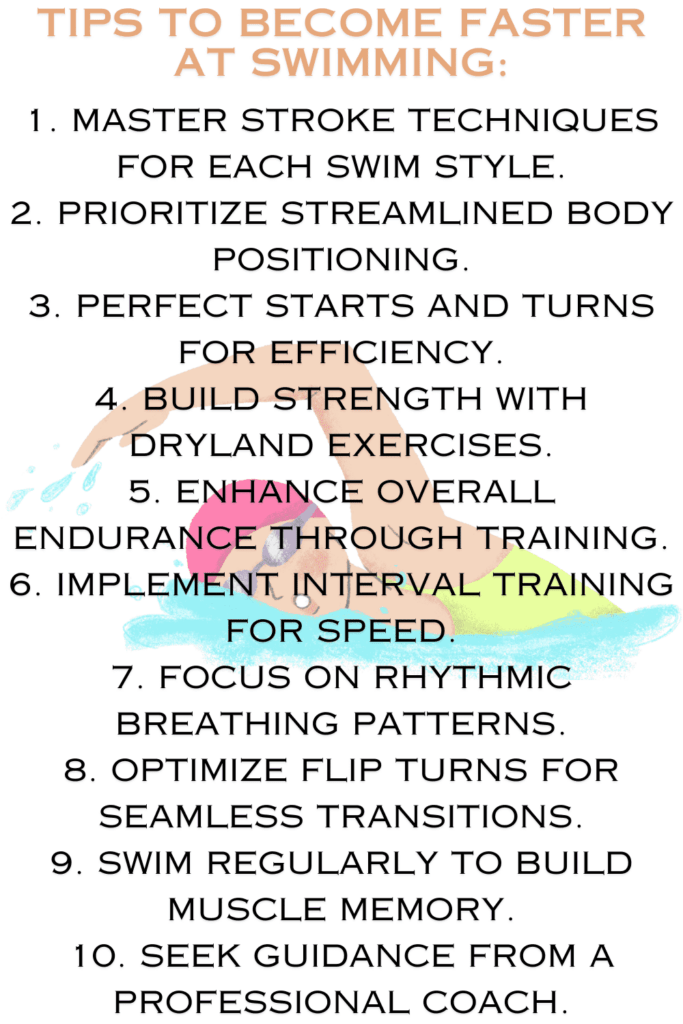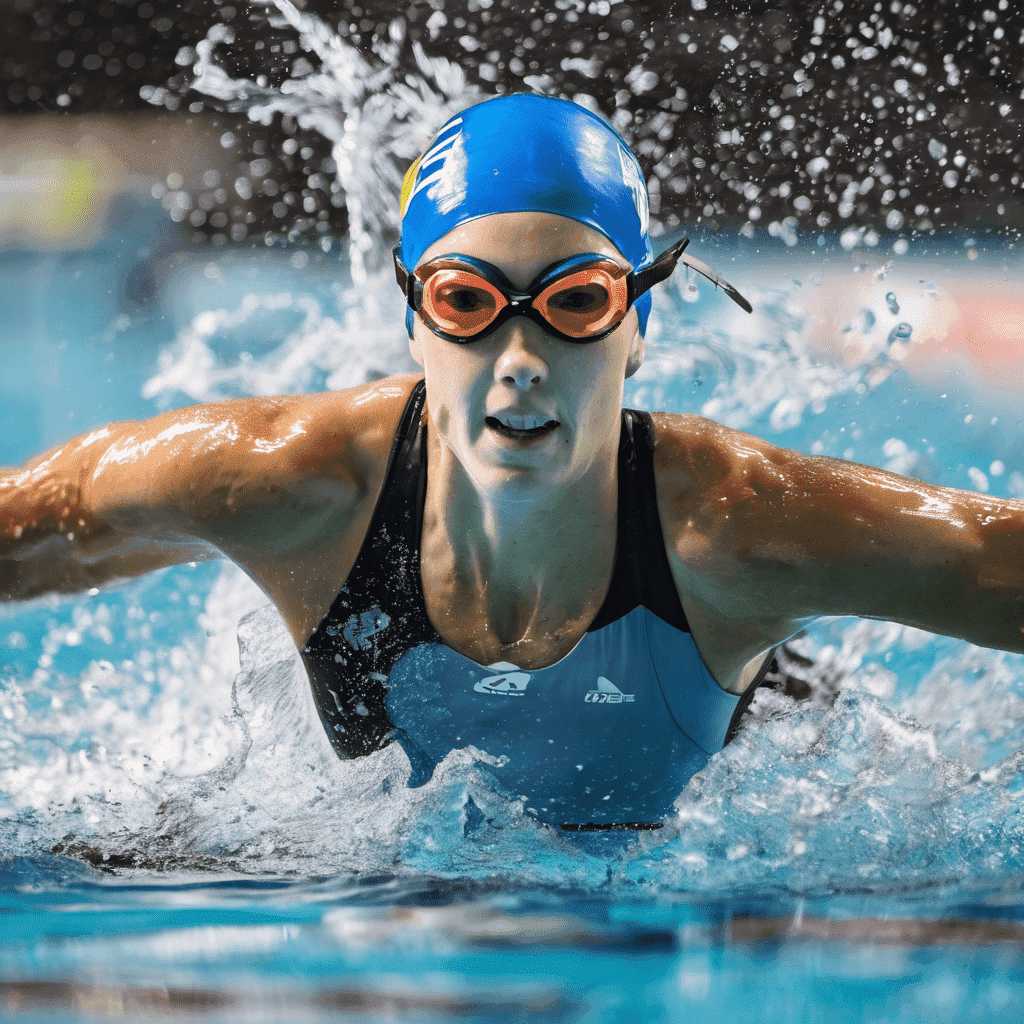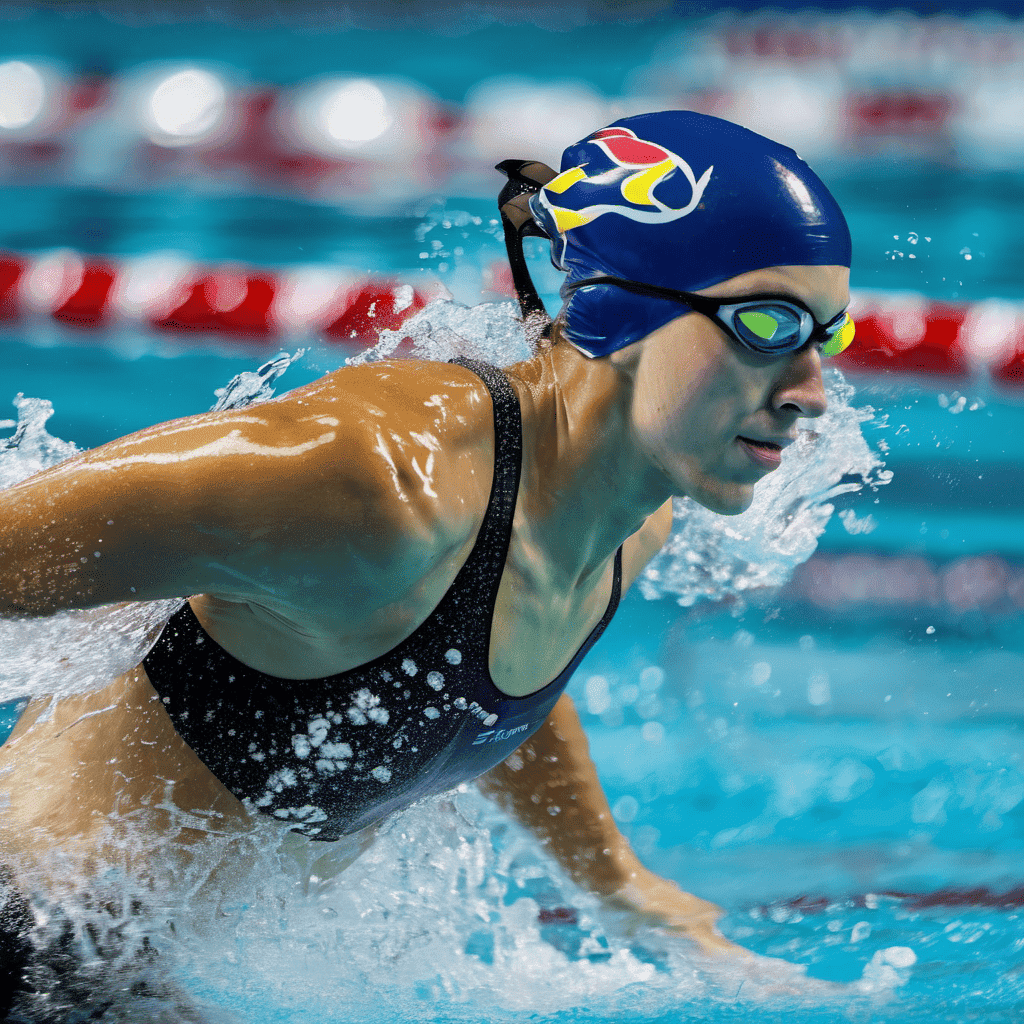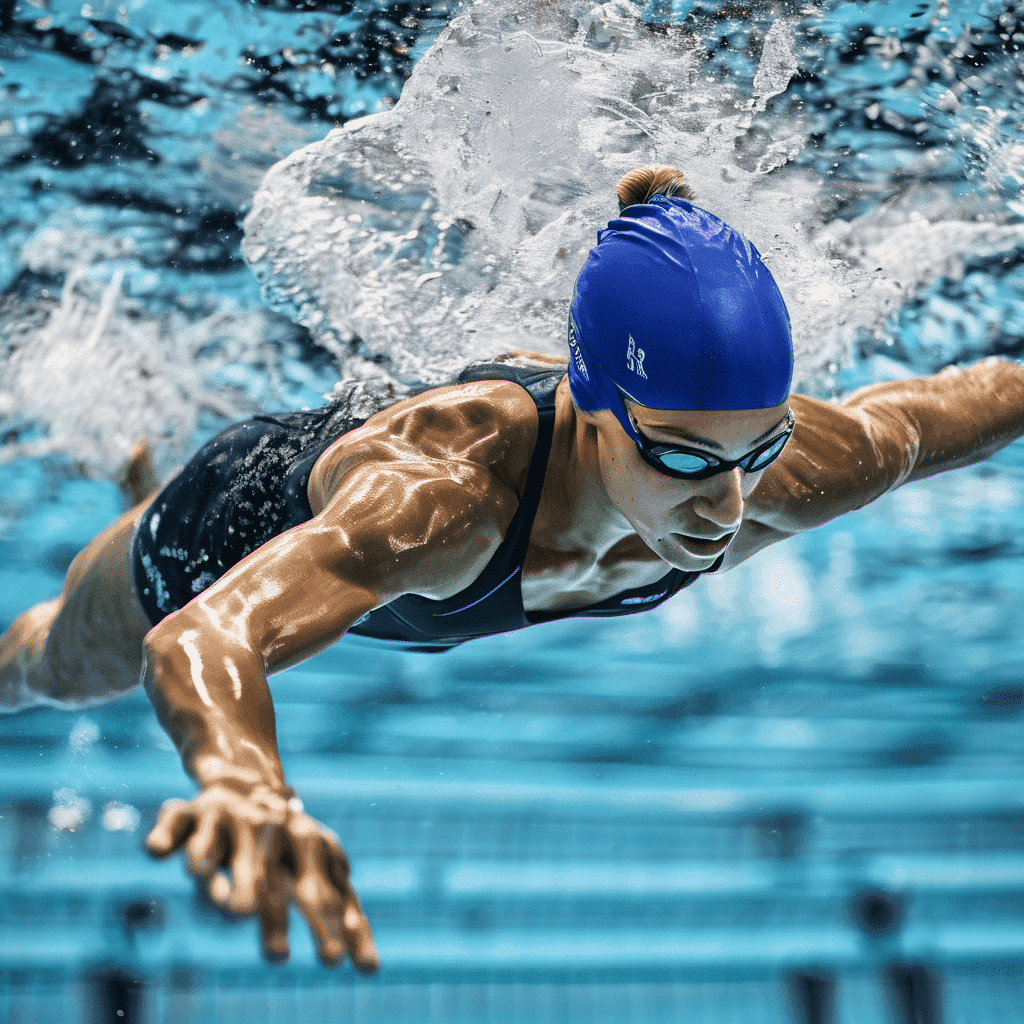
Swimming, a versatile and rewarding activity, not only offers a refreshing escape but also serves as a comprehensive workout. Whether you’re a competitive swimmer or a recreational enthusiast, the desire to enhance speed and efficiency in the water is universal. This guide explores key strategies to help you get faster at swimming. From mastering stroke techniques and optimizing streamlining to refining starts, turns, and breathing patterns, each aspect contributes to improved performance. Strengthening core muscle groups through dryland exercises, incorporating interval training, and seeking professional coaching further complement these efforts. By embracing a holistic approach that combines technique refinement, physical conditioning, and expert guidance, you can unlock your swimming potential, shave precious seconds off your lap times, and enjoy a heightened sense of accomplishment in the water.
Here is some of the best ways to get faster at swimming.
Tips to become Faster at Swimming:
Here are 10 best tips that’s help you to become a faster swimmer in the the world.
1. Master stroke techniques for each swim style.
2. Prioritize streamlined body positioning.
3. Perfect starts and turns for efficiency.
4. Build strength with dryland exercises.
5. Enhance overall endurance through training.
6. Implement interval training for speed.
7. Focus on rhythmic breathing patterns.
8. Optimize flip turns for seamless transitions.
9. Swim regularly to build muscle memory.
10. Seek guidance from a professional coach.
Let’s talk at about each tip for faster swimming with more detail.
1. Master stroke techniques for each swim style.
Mastering stroke techniques is crucial for improving speed and efficiency in swimming. Each swim style—freestyle, backstroke, breaststroke, and butterfly—has specific nuances that, when perfected, contribute to enhanced performance. In freestyle, focus on a long and powerful arm pull, maintaining a streamlined body position, and a consistent flutter kick to minimize resistance. For backstroke, efficient arm movements and a steady flutter kick are essential, with emphasis on body rotation for optimal speed. Breaststroke requires a powerful and symmetrical frog kick, coordinated arm movements, and a streamlined glide phase to maximize propulsion. Butterfly demands a strong dolphin kick, a powerful simultaneous arm pull, and an undulating body motion for speed. Consistent practice and attention to these stroke-specific techniques are integral to mastering each style and ultimately becoming faster at swimming.
2. Prioritize streamlined body positioning.
Prioritizing streamlined body positioning is a crucial aspect of becoming a faster swimmer. Streamlining refers to minimizing water resistance and drag to move through the water more efficiently. Here are some detailed tips on how to prioritize streamlined body positioning to improve your speed in swimming:
-
-
Body Alignment:
-
Ensure that your body is in a straight line from head to toe. Avoid any unnecessary movements or tilting that can increase drag.
Keep your head in a neutral position, looking straight ahead, and avoid lifting it too high, which can disrupt the streamlined flow.
-
-
Head Position:
-
Position your head so that it is in line with your spine, and tuck your chin slightly to avoid unnecessary resistance.
Practice breathing techniques that minimize head movement. Bilateral breathing (breathing on both sides) can help maintain balance and streamline.
-
-
Arm Technique:
-
Focus on a high elbow catch during the underwater phase of the arm stroke. This allows for a more efficient pull through the water.
Keep your arms close together and streamlined in front of your body to reduce frontal resistance.
Work on a smooth transition between strokes, minimizing any unnecessary splashing or lateral movements.
-
-
Hand Entry:
-
Enter the water with your hand in line with your shoulder and extend it forward before beginning the pull phase. This minimizes resistance during the entry.
Aim for a gentle and controlled hand entry to avoid splashing and turbulence, which can slow you down.
-
-
Body Roll:
-
Incorporate a proper body roll into your stroke technique. A controlled rotation of the body with each stroke helps to engage the larger muscles and reduces resistance.
The body roll also allows for a longer reach, maximizing the distance covered with each stroke.
-
-
Kicking Technique:
-
Keep your legs straight and close together, with a slight bend in the knees. Excessive leg movement can create drag.
Kick from your hips rather than your knees, focusing on a small and quick flutter kick to maintain streamlined propulsion.
-
-
Tight Streamline Off Starts and Turns:
-
When pushing off the wall or starting a race, assume a tight streamline position by extending your arms overhead and clasping your hands together.
Maintain this streamlined position until you begin your regular stroke. This helps capitalize on the initial burst of speed without unnecessary resistance.
-
-
Underwater Dolphin Kicking:
-
Incorporate underwater dolphin kicks off the wall and during turns. This powerful kick is performed with the whole body moving in a wave-like motion, reducing drag and maximizing speed.
-
-
Video Analysis:
-
Use underwater video analysis to identify areas where you can improve your streamlined body positioning. Analyzing your technique visually can provide valuable insights into areas for refinement.
-
-
Consistent Practice:
-
Streamlined body positioning is a skill that improves with consistent practice. Focus on one aspect at a time, gradually incorporating these techniques into your regular training sessions.
-
- By prioritizing streamlined body positioning and consistently refining your technique, you can significantly enhance your swimming speed and efficiency in the water. Regular feedback from coaches and video analysis can further aid in identifying areas for improvement.

3. Perfect starts and turns for efficiency.
Perfecting your starts and turns is crucial for enhancing efficiency and overall speed in swimming. Both the dive off the starting block and the execution of turns can significantly impact your performance in the pool. Here are detailed tips on perfecting starts and turns for efficiency:
Starts:
-
- Positioning: Set up on the starting block with your feet shoulder-width apart, toes gripping the edge. Your weight should be slightly forward.
- Body Position: Maintain a streamlined body position with arms extended overhead, hands clasped together, and head down.
- Reaction Time: Work on your reaction time to the starting signal. Anticipate the signal without false starting.
- Explosive Push: Push off the block explosively using your legs, engaging the glutes and quads. The goal is to minimize the time spent on the block and maximize the initial propulsion.
Turns:
-
- Approach: As you approach the wall, maintain a steady and controlled speed. The last strokes leading to the turn should be powerful and well-timed.
- Distance from the Wall: Gauge the distance from the wall to time your flip turn correctly. Practice the turn at various distances to find the optimal point for your stroke.
- Tuck and Rotation: Perform a quick tuck with your knees towards your chest as you initiate the flip. Simultaneously, initiate a quick rotation onto your stomach.
- Plant the Feet: As your body completes the rotation, plant your feet firmly on the wall. Keep your knees bent at approximately a 90-degree angle.
- Explosive Push Off: Push off the wall with power, using your legs to generate momentum. Aim to streamline off the wall with arms extended.
- Underwater Dolphin Kick: Utilize underwater dolphin kicks immediately after the push-off for streamlined propulsion. These kicks can cover a significant distance underwater, reducing drag.
4. Build strength with dryland exercises.
Building strength with targeted dryland exercises is a critical component in the quest to enhance speed and performance in swimming. Dryland training focuses on strengthening key muscle groups that are integral to efficient swimming, including the core, shoulders, and legs. Incorporating exercises such as planks, squats, lunges, and resistance training helps improve overall muscular endurance and power. A strong core is especially vital in maintaining a streamlined body position, reducing drag, and optimizing stroke efficiency. Specific shoulder exercises, such as lateral raises and shoulder presses, contribute to the power and precision required for effective arm movements. Leg strength, developed through exercises like box jumps and leg presses, is essential for generating powerful kicks and push-offs during starts and turns.
In addition to muscle strength, dryland exercises also play a role in injury prevention and overall stability. Strengthening the stabilizing muscles around the joints helps reduce the risk of injuries commonly associated with swimming. A well-rounded dryland routine, incorporated into the overall training regimen, ensures that swimmers develop the physical strength and resilience needed to withstand the demands of the water. As strength increases, swimmers can exert more force in each stroke, resulting in improved speed, endurance, and overall efficiency in the pool.
5. Enhance overall endurance through training.
Enhancing overall endurance is a critical component of getting faster at swimming. A well-rounded training regimen should incorporate both pool and dryland exercises to build cardiovascular fitness and stamina. Swim longer distances with interval training, gradually increasing the intensity to challenge your endurance limits. Additionally, complement your pool sessions with dryland exercises focusing on core strength, leg power, and cardiovascular conditioning. High-intensity interval training (HIIT) can be particularly effective in improving your body’s ability to sustain intense efforts, translating into increased speed and efficiency in the water. Consistent and progressively challenging endurance training not only boosts your aerobic capacity but also prepares your muscles for the sustained effort required in competitive or extended swimming sessions, ultimately contributing to improved overall performance and speed.
6. Implement interval training for speed.
Implementing interval training is a key strategy for enhancing speed in swimming. Interval training involves alternating between periods of high-intensity swimming and designated rest or lower-intensity periods. This approach not only improves cardiovascular fitness but also simulates the variable pace of competitive races, conditioning your body for bursts of intense effort. During high-intensity intervals, focus on maintaining proper stroke technique and maximizing your speed. The structured nature of interval training allows for targeted improvements in both anaerobic and aerobic capacities, contributing to increased swimming speed over time. Whether it’s sprint sets or timed repetitions, incorporating interval training into your swim workouts challenges your body to adapt to varying intensities, translating to improved overall speed, endurance, and race-readiness in the pool.
7. Focus on rhythmic breathing patterns.
Focusing on rhythmic breathing patterns is a fundamental aspect of improving speed in swimming. Efficient breathing not only ensures a steady oxygen supply to your muscles but also plays a crucial role in maintaining a consistent and efficient stroke rhythm. In freestyle and backstroke, coordinating your breathing with your arm strokes is essential for minimizing disruptions to your streamlined body position. Establish a breathing pattern that suits your stroke style, inhaling during specific phases and exhaling during others. Consistency in your breathing rhythm helps optimize the oxygen exchange process, preventing fatigue and allowing you to sustain higher speeds for longer durations.
Moreover, rhythmic breathing is particularly significant in bilateral breathing, where you alternate breathing sides. This technique promotes balance and symmetry in your stroke, reducing the likelihood of overusing one side and causing imbalances. By honing your ability to breathe rhythmically, you not only enhance your endurance but also develop a smoother, more controlled swimming technique. Practicing breathing drills, such as breathing every three strokes or incorporating breath control sets, can refine your respiratory efficiency, contributing to improved overall speed and performance in the water.
8. Optimize flip turns for seamless transitions.
Optimizing flip turns is a crucial element in the quest to become faster at swimming, as seamless transitions at the pool wall can significantly impact overall lap times. A well-executed flip turn minimizes the time spent at each wall, ensuring a continuous and efficient swim. As you approach the wall, initiate the flip with a strong and swift tuck, rotating your body along a horizontal axis. The goal is to execute the turn smoothly, minimizing resistance and maintaining momentum through the rotation. Timing is key, and by practicing the flip turn regularly, swimmers can develop muscle memory and improve their ability to seamlessly transition from one lap to the next.
Effective flip turns involve a combination of technique and precision. Engage your core muscles during the flip to maintain a tight and streamlined position, allowing for a quick push-off from the wall. The push-off should be powerful and directed, using the legs to generate momentum for the next lap. Additionally, mastering the art of streamlining after the turn is crucial. Extend your arms overhead, streamline your body, and kick off the wall in a streamlined position to reduce drag and maximize efficiency as you resume swimming. Regular drills focusing on flip turns, including practicing open turns and gradually integrating flip turns into longer swim sets, contribute to the development of a fluid and efficient transition technique, ultimately leading to faster overall swim times.
9. Swim regularly to build muscle memory.
Swimming regularly is a fundamental strategy for building muscle memory, a key aspect in the pursuit of increased speed and efficiency in the water. Muscle memory refers to the brain’s ability to memorize and automate specific movements through repetitive practice. In the context of swimming, consistent exposure to the water helps establish and reinforce neural pathways associated with proper stroke techniques, streamline positions, and overall efficient movements. Regular swim sessions not only improve physical conditioning but also allow swimmers to engrain the precise muscle activation patterns necessary for executing each stroke with optimal form. This repetition helps the body adapt to the dynamic and coordinated movements required in swimming, facilitating a more natural and instinctive execution of strokes.
Moreover, swimming regularly provides an opportunity to fine-tune and perfect various aspects of technique. Whether it’s refining the catch and pull phases of the freestyle stroke or mastering the intricate movements of the butterfly, the consistent repetition of these motions during regular swim sessions allows swimmers to identify areas for improvement and make necessary adjustments. Muscle memory not only aids in executing technical aspects but also contributes to enhanced pacing and strategic energy distribution during swims. By making swimming a consistent part of the routine, swimmers reinforce the neuromuscular connections that lead to fluid and efficient movements, ultimately contributing to increased speed and improved performance in the water.
10. Seek guidance from a professional coach.
Seeking guidance from a professional coach is a pivotal step in the journey to become faster at swimming. A qualified coach brings a wealth of expertise, personalized feedback, and structured training plans that cater to an individual’s specific strengths and weaknesses. Coaches analyze stroke techniques, streamline positions, and overall swim mechanics, providing invaluable insights that might go unnoticed during self-practice. Their trained eye can pinpoint areas for improvement, allowing swimmers to focus on targeted drills and exercises to enhance efficiency and speed. A coach’s feedback is instrumental in refining techniques, correcting form, and instilling good habits that directly contribute to improved performance.
Beyond technical aspects, coaches play a crucial role in developing a well-rounded training regimen. They create periodized plans that balance intensity, volume, and recovery, ensuring swimmers progress in a systematic and sustainable manner. Professional guidance also extends to mental preparation, race strategy, and goal setting, fostering a holistic approach to performance improvement. Coaches provide motivation, encouragement, and accountability, creating a supportive environment that inspires swimmers to push their limits. Whether you’re a competitive athlete or a recreational swimmer, the mentorship of a professional coach acts as a compass, guiding your journey towards increased speed, efficiency, and overall excellence in the realm of swimming.
Consultation with a Professional:
Engaging in a consultation with a professional is a strategic move for those aspiring to accelerate their swimming performance. This one-on-one interaction often involves a detailed analysis of an individual’s current swimming abilities, strengths, weaknesses, and specific goals. A professional consultant, such as a swim coach or a sports physiologist, conducts a comprehensive assessment of your stroke techniques, streamline positions, and overall swimming mechanics. Through video analysis and real-time observation, they can identify nuances that may be hindering optimal performance, offering personalized insights that can be instrumental in refining your technique for speed and efficiency.
The consultation process extends beyond technical evaluation. Professionals may assess your overall fitness level, flexibility, and muscular imbalances to tailor a training plan that addresses specific areas of improvement. They can provide guidance on dryland exercises, strength training, and cardiovascular conditioning that complements your swim training, contributing to enhanced endurance and power. A personalized approach also considers individualized recovery strategies to prevent injuries and ensure sustained progress. Moreover, these professionals offer valuable advice on mental preparation, race strategies, and goal-setting, helping swimmers develop a holistic and focused mindset that is crucial for success in competitive swimming. In essence, a consultation with a professional provides a roadmap for your swimming journey, offering expert guidance and insights that can significantly propel you toward achieving your goals for increased speed and overall performance in the water.
Conclusion:
In conclusion, the journey to getting faster at swimming is a multifaceted process that combines meticulous attention to technique, strategic training, and expert guidance. Mastery of stroke techniques, optimization of flip turns, focus on rhythmic breathing, and implementation of interval training are fundamental components, each contributing to improved speed and efficiency in the water. Building strength through targeted dryland exercises and swimming regularly to establish muscle memory are integral aspects of physical conditioning. Seeking the guidance of a professional coach or consultant adds a layer of personalized insight, ensuring a holistic approach to training that encompasses technical refinement, physical fitness, and mental preparedness. By embracing these comprehensive strategies, swimmers of all levels can unlock their full potential, achieving not only increased speed but also a heightened sense of accomplishment and proficiency in the invigorating realm of swimming.
FAQs about How to Get Faster at Swimming:
Q: What’s the most important aspect of freestyle technique for speed?
A: Body rotation and core engagement are crucial for maximizing power and propulsion. Drills like single-arm freestyle and sculling help isolate and strengthen these key muscles.
Q: How can I improve my kicking and make it more efficient?
A: Focus on a strong flutter kick with minimal splash, using your ankles and not just your knees. Drills like flutter kicks with fins and ankle-band kicks can refine your technique.
Q: Are there any drills to help me streamline my body and reduce drag?
A: Absolutely! Practice body glide, streamline hold, and fingertip drag drills to learn a sleek body position and minimize resistance in the water.
Q: Should I focus on swimming more or doing strength training to get faster?
A: A balanced approach is best! High-intensity interval training (HIIT) builds speed and endurance, while longer swims improve aerobic capacity. Strength training adds power and prevents injuries.
Q: How often should I be swimming to see improvement?
A: Aim for at least 3-4 swim sessions per week, with a mix of intensity and distance. Consistency is key, but don’t forget to schedule rest and recovery days for optimal results.
Q: What are some common mistakes beginners make when training for speed?
A: Overtraining, neglecting technique, and forgetting to breathe properly can hinder progress. Start slow, focus on form, and listen to your body to avoid burnout and injuries.
Q: How can I overcome mental blocks and swim with more confidence?
A: Visualize success, set achievable goals, and celebrate your progress. Focus on your strengths and believe in your ability to improve. Consider joining a swim team or finding a training buddy for support and motivation.
Q: What keeps me motivated to stay consistent with my training?
A: Set clear goals, track your progress, and reward yourself for milestones. Find joy in the process, experiment with different training methods, and surround yourself with positive and supportive people.
Q: What can I do if I hit a plateau in my swimming performance?
A: Analyze your training, address technical inefficiencies, switch up your routine, and seek coaching advice. Consider short breaks to avoid burnout and prevent plateaus.
Q: Are there any tools or resources I can use to improve my swimming?
A: Training logs, workout apps, heart rate monitors, video analysis, and coaching resources can help track progress, identify areas for improvement, and personalize training plans.
Q: What are some inspiring stories of swimmers who overcame challenges and achieved success?
A: Research athletes like Michael Phelps or Diana Nyad for motivation and guidance. Their stories can provide hope and inspiration for your own swimming journey.
What are some tips for swimming faster and more efficiently without losing any endurance?
Improving your swimming speed and efficiency while maintaining endurance involves focusing on technique, strength, and smart training. Work on refining your strokes for better propulsion, streamline your body position, and optimize your turns. Incorporate interval training to build both speed and endurance. Strengthen core muscles for improved stability. Consistent practice, drills, and a balanced training regimen will help you swim faster without sacrificing endurance





